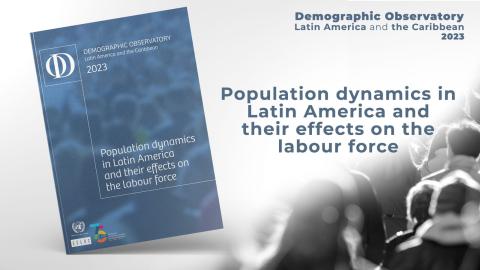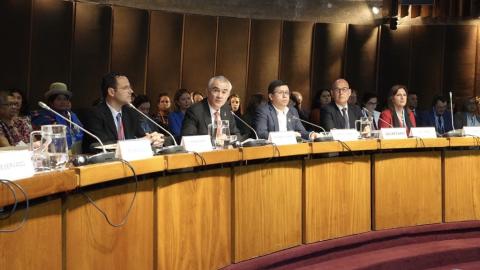Press Release
The slowdown in population growth, mainly due to the falling fertility rate and negative migration balances will lead Latin America and the Caribbean to reach maximum population by around 2058, with a total of 767.5 million people, according to an analysis of recent population trends in the region, carried out by the Economic Commission for Latin America and the Caribbean (ECLAC).
As of 2059, diminishing population growth is therefore predicted for the region, in contrast to the outlook at the global level, where, although the population will decline, negative growth is not foreseen in the next 80 years.
The analysis, released today in the context of World Population Day, contains estimates and projections based on recent trends in Latin America and the Caribbean for the period 2015-2020 and were prepared by the Latin American and Caribbean Demographic Center (CELADE)-Population Division of ECLAC.
According to the study, whose figures were recently published by the United Nations, Latin America and the Caribbean went from median annual growth of 4.8 million persons in the five-year period from 1950-1955 to a maximum of nearly 8.2 million in 1985-1990. As of 1990, population growth for the region began to decline and currently the population is growing at a pace of 6 million people per year.
In the process of demographic transition in the region, the accelerated fall in fertility stands out, which was preceded by a sustained reduction in mortality since the end of the first half of the twentieth century, today reflected in a life expectancy of 75.2 years and a global fertility rate of two children per woman.
The demographic transition has been accelerated, albeit with varying aspects across and within countries. Overall, it has resulted in two major changes at the regional level: a reduction in demographic dependence and aging populations. The analysis posits that, while the decrease in relation to dependence will contribute to a demographic easing in the medium term, the aging population presents challenges for societies.
For the period 2020-2025, the dependent population (minors under 15 and persons 65 and older) will grow more than the population of working age (from 15 to 64), which indicates the end of the regional demographic bonus, although with differences between countries.
The end of the demographic bonus is accompanied by an accelerated process of aging in the population, with an increase in proportion and absolute number persons aged 65 and older. This population will increase in a sustained manner in the upcoming decades and it is expected that by 2047, it will surpass the population of minors under 15. In the region, projections indicate 1 in 5 inhabitants will be a person over the age of 65 in 2050.
Life expectancy as of birth, meanwhile, continues on the rise. Nevertheless, Latin America and the Caribbean is the region with the second-lowest increase in the world, with an average increase of 0.8 years in 2015-2020, barely behind North America, which will have a negative increase of 0.07 for the same period.
The region has a life expectancy as of birth of 75.2 years, situating it above Asia (73.3) and Africa (62.7), although it maintains a significant gap with respect to North America (79.2) and Europe (78.3) and Oceania (78.4). The projections show a greater convergence in life expectancy across regions, but not sufficiently fast enough to close the existing gaps between regions with higher levels of mortality.
Heterogeneity within the region persists, with a difference of 18.7 years between Martinique (82.3) and Haiti (63.5), both countries in the Caribbean region.
Estimates for the mortality rate in children under 5, meanwhile, indicates a reduction, going from 21.04 deaths of children under age 5 per thousand births in the period 2010-2015 to 19.1 in 2015-2020. Nevertheless, mortality continues to be high and is nearly four times that observed in Europe for the same period.
The global fertility rate for Latin America and the Caribbean is estimated at 2.04 live births per woman, placing the region for the first time below the level of replacement of 2.1 live births per woman. It is projected that the Global Fertility Rate (GFR) for the region will continue to decline and reach 1.72 by the period 2070-2075.
The analysis done by ECLAC furthermore reveals that the median age of fertility had its lowest value in the region in 2000-2005, at 27.0 years and has begun to rise ever since. Currently, an age of 27.3 years is observed for 2015-2020, indicating that the low fertility is accompanied by a greater number of women having children later in life. Based on these projections, the average age is expected to reach 30.7 by the period 2095-2100.
With respect to the fertility rate in adolescents aged 15 to 19, estimates indicate that it has fallen from 68.1 live births per thousand women in 2010-2015 to 63 in 2015-2020; however, the rate continues high compared to other regions of the world and is 48% higher than the world average.
Finally, ECLAC’s figures reveal an increase in intra-regional migration in recent years. A recent example is the migration of persons residing in Haiti to South American countries, and the migration wave of people from Venezuela. These movements have produced significant changes in migration balances in receiving countries, as well as in the countries of origin. It is estimated that for the period 2015-2020, the migration balance for Venezuela is 3.3 million people and that, within the region, the countries receiving these migrants were Brazil, Chile, Colombia, Ecuador and Perú.



